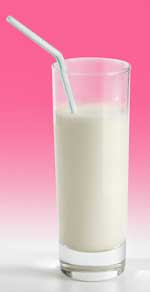Lactose Intolerance: Symptoms, Causes and
Management

Being unable to tolerate lactose can play havoc with normal eating habits, but it is something that can be adapted to. But what exactly does lactose intolerance mean, why does it happen and how can you cope with it?
Lactose intolerance is a condition where people are unable to absorb significant amounts of lactose — one of the main sugars found in milk — into their digestive system.
Lactose consists of two sugars which are joined together. To be absorbed properly, it has to be split into the two smaller sugars. An enzyme called lactase, which is present in the small intestine lining, helps perform this split.
If there’s not enough lactase or none at all, the split doesn’t happen. As a result, the lactose ends up being fermented by the bacteria in the large intestine and this causes a range of unpleasant symptoms.
The symptoms of lactose intolerance can be very distressing. They include nausea, stomach cramps and pain, a rumbling stomach, bloating, wind and diarrhea. If food or drinks containing lactose are consumed, the symptoms often come on from between half an hour and two hours afterwards.
If you’re suffering from the symptoms it’s important to get it confirmed by a doctor, rather than trying to self-diagnose, as the symptoms could be due to another underlying condition. Your doctor can do a simple lactose intolerance test, which involves measuring your blood sugar levels before and after drinking a liquid containing lactose. There’s also a similar breath test available, or you might need to have a sample taken for testing from the lining of your small intestine.
There’s currently no definitive cure for lactose intolerance. However, there are ways of coping with it.
One way of coping is to avoid consuming any dairy products, drinks or other foods containing lactose. Although it can be tricky, it’s manageable by reading food labels carefully or checking the ingredients of foods if you’re eating out. It’s also possible to cope with it through taking enzyme tablets when you eat or drink. These help replace the lactase that your body isn’t producing and helps your digestive system.
Lactose is often hidden in lots of foods where we wouldn’t necessarily expect it to be, such as ham, gravy, pizza, bread and even sherbet. This can make it hard for lactose intolerance sufferers, as they have to be on the ball and ready to spot it.
Lactose intolerance can develop at any time, even if you’ve been in perfect health previously. Many people, for example, become lactose intolerant after they’ve suffered a bout of diarrhea. The lining of the small intestine can become damaged, which reduces the production of lactase. Others who’ve had major surgery, such as on the bowel or stomach, or suffer from Coeliac disease, can also be prone to being lactose intolerant.
Article by Rachel Newcombe.
|